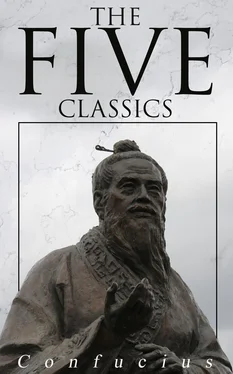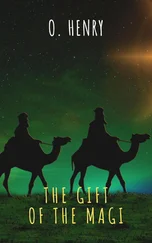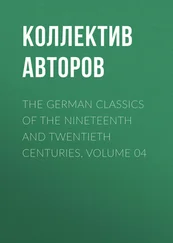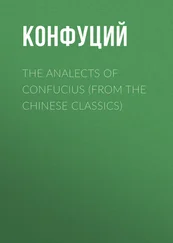Much of what I wrote was made up, in consequence, of so many English words, with little or no mark of syntactical connexion. I followed in this the example of P. Regis and his coadjutors (Introduction, page p. 9) in their Latin version. But their version is all but unintelligible, and mine was not less so. How to surmount this difficulty occurred to me after I had found the clue to the interpretation;--in a fact which I had unconsciously acted on in all my translations of other classics) namely, that the written characters of the Chinese are not representations of words, but symbols of ideas, and that the combination of them in composition is not a representation of what the writer would say, but of what he thinks. It is vain therefore for a translator to attempt a literal version. When the symbolic characters have brought his mind en rapport with that of his author, he is free to render the ideas in his own or any other speech in the best manner that he can attain to. This is the rule which Mencius followed in interpreting the old poems of his country:--'We must try with our thoughts to meet the scope of a sentence, and then we shall apprehend it.' In the study of a Chinese classical book there is not so much an interpretation of the characters employed by the writer as a participation of his thoughts;--there is the seeing of mind to mind. The canon hence derived for a translator is not one of license. It will be his object to express the meaning of the original as exactly and concisely as possible. But it will be necessary for him to introduce a word or two now and then to indicate what the mind of the writer supplied for itself. What I have done in this way will generally be seen enclosed in parentheses, though I queried whether I might not dispense with them, as there is nothing in the English version which was not, I believe, present in the writer's thought. I hope, however, that I have been able in this way to make the translation intelligible to readers. If, after all, they shall conclude that in what is said on the hexagrams there is often 'much ado about nothing,' it is not the translator who should be deemed accountable for that, but his original.
I had intended to append to the volume translations of certain chapters from K û Hsî and other writers of the Sung dynasty; but this purpose could not be carried into effect for want of space. It was found necessary to accompany the version with a running commentary, illustrating the way in which the teachings of king Wăn and his son are supposed to be drawn from the figures and their several lines; and my difficulty was to keep the single Yî within the limits of one volume. Those intended translations therefore are reserved for another opportunity; and indeed, the Sung philosophy did not grow out of the Yî proper, but from the Appendixes to it, and especially from the third of them. It is more Tâoistic than Confucian.
When I first took the Yî in hand, there existed no translation of it in any western language but that of P. Regis and his coadjutors, which I have mentioned above and in various places of the Introduction. The authors were all sinologists of great attainments; and their view of the Text as relating to the transactions between the founders of the K âu dynasty and the last sovereign of the Shang or Yin, and capable of being illustrated historically, though too narrow, was an approximation to the truth. The late M. Mohl, who had edited the work in 1834, said to me once, 'I like it; for I come to it out of a sea of mist, and find solid ground.' No sufficient distinction was made in it, however, between the Text and the Appendixes; and in discussing the third and following Appendixes the translators were haunted by the name and shade of Confucius. To the excessive literalness of the version I have referred above.
In 1876 the Rev. Canon McClatchie, M.A., published a version at Shanghai with the title, 'A Translation of the Confucian Yî King, or the "Classic of Changes," with Notes and Appendix.' This embraces both the Text and the Appendixes, the first, second, and fourth of the latter being interspersed along with the Text, as in the ordinary school editions of the classic. So far as I can judge from his language, he does not appear to be aware that the first and second Appendixes were not the work of king Wăn and the duke of K âu, but of a subsequent writer--he would say of Confucius--explaining their explanations of the entire hexagrams and their several lines. His own special object was 'to open the mysteries of the Yî by applying to it the key of Comparative Mythology.' Such a key was not necessary; and the author, by the application of it, has found sundry things to which I have occasionally referred in my notes. They are not pleasant to look at or dwell upon; and happily it has never entered into the minds of Chinese scholars to conceive of them. I have followed Canon McClatchie's translation from paragraph to paragraph and from sentence to sentence, but found nothing which I could employ with advantage in my own.
Long after my translation had been completed, and that of the Text indeed was printed, I received from Shanghai the third volume of P. Angelo Zottoli's 'Cursus Litteraturae Sinicae,' which had appeared in 1880. About 100 pages of it are occupied with the Yî. The Latin version is a great improvement on that in the work of Regis; but P. Zottoli translates only the Text of the first two hexagrams, with the portions of the first, second, and fourth Appendixes relating to them; and other six hexagrams with the explanations of king Wăn's Thwan and of the Great Symbolism. of the remaining fifty-six hexagrams only the briefest summary is given; and then follow the Appendixes III, V, VI, and VII at length. The author has done his work well. His general view of the Yî is stated in the following sentences:--'Ex Fû-hsî figuris, Wăn regis definitionibus, K âu ducis symbolis, et Confucii commentariis, Liber conficitur, qui a mutationibus, quas duo elementa in hexagrammatum compositione inducunt, Yî (Mutator) vel Yî King (Mutationum Liber) appellatur. Quid igitur tandem famosus iste Yî King? Paucis accipe: ex linearum qualitate continua vel intercisa; earumque situ, imo, medio, vel supremo; mutuaque ipsarum relatione, occursu, dissidio, convenientia; ex ipso scilicet trigrammatum corpore seu forma, tum ex trigrammatum symbolo seu imagine, tum ex trigrammatum proprietate seu virtute, tum etiam aliquando ex unius ad alterum hexagramma varietate, eruitur aliqua imago, deducitur aliqua sententia, quoddam veluti oraculum continens, quod sorte etiam consulere possis ad documentum obtinendum, moderandae vitae solvendove dubio consentaneum. Ita liber juxta Confucii explicationem in scholis tradi solitam. Nil igitur sublime aut mysteriosum, nil foedum aut vile hic quaeras; argutulum potius lusum ibi video ad instructiones morales politicasque eliciendas, ut ad satietatem usque in Sinicis passim classicis, obvias, planas, naturales; tantum, cum liber iste, ut integrum legenti textum facile patebit, ad sortilegii usum deductus fuerit, per ipsum jam summum homo obtinebit vitae beneficium, arcanam cum spiritibus communicationem secretamque futurorum eventuum cognitionem; theurgus igitur visus est iste liber, totus lux, totus spiritus, hominisque vitae accommodatissimus; indeque laudes a Confucio ei tributas, prorsus exaggeratas, in hujus libri praesertim appendice videre erit, si vere tamen, ut communis fert opinio, ipse sit hujus appendicis auctor.'
There has been a report for two or three years of a new translation of the Yî, or at least of a part of it, as being in preparation by M. Terrien de Lacouperie, and Professor R. K. Douglas of the British Museum and King's College, London. I have alluded on pages 8, 9 of the Introduction to some inaccurate statements about native commentaries on the Yî and translations of it by foreigners, made in connexion with this contemplated version. But I did not know what the projected undertaking really was, till I read a letter from M. Terrien in the 'Athenæum' of the 21st January of this year. He there says that the joint translation 'deals only with the oldest part of the book, the short lists of characters which follow each of the sixty-four headings, and leaves entirely aside the explanations and commentaries attributed to Wen Wang, K âu Kung, Confucius, and others, from 1200 B. C. downwards, which are commonly embodied as an integral part of the classic;' adding, 'The proportion of the primitive text to these additions is about one-sixth of the whole.' But if we take away these explanations and commentaries attributed to king Wăn, the duke of K âu, and Confucius, we take away the whole Yî. There remain only the linear figures attributed to Fû-hsî, without any lists of characters, long or short, without a single written character of any kind whatever. The projectors have been misled somehow about the contents of the Yî; and unless they can overthrow all the traditions and beliefs about them, whether Chinese or foreign, their undertaking is more hopeless than the task laid on the children of Israel by Pharaoh, that they should make bricks without straw.
Читать дальше












